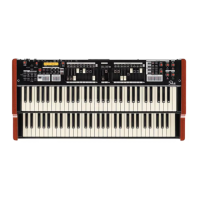51
Setting Up
LESLIE
e rotating sound of the LESLIE Speaker is the natural partner of the Ham-
mond Organ. A Digital version is built-in to the SKX; and the controls will
also function with a connected physical Leslie.
[FAST] button
Toggles the mode of the Rotor by two steps. Every press switches
the status. When the LED is lit, the mode is “FAST”, and when it
is not lit, it is “SLOW” or “STOP”.
[STOP] button
To toggle the “FAST” and “SLOW” when you pressed the [FAST]
button, turn this button “OFF” (LED not lit).
To toggle the “FAST” and “STOP” when you pressed the [FAST]
button, turn this button “ON” (LED lit).
[BYPASS] button
When the LED for this button is “OFF”, the Organ section sound
is output from the rotary channel (Leslie e ect).
To bypass the Leslie e ect, press this button and the light will go
ON. Regardless of the status of the [FAST], [STOP] buttons, the
Organ section sound is output from the stationary channel.
NOTE: Leslie E ect is available on Organ section except Pipe type.
NOTE: You can ne-tune the parameters of the Leslie e ect. (P. 82)
BUTTON MODE
BYPASS STOP FAST CH=1
CH=3,
on-board
Leslie effect
O O On Fast
O O O Slow
O On On Fast
O On O Stop
On On On Fast
Bypass
On On
O Stop
On
O On Fast
On O O Slow
STATUS CHART OF EACH BUTTON
800Hz
Ampli-
fier
Horn
Driver
Woofer
Bass
Rotor
Horn
Rotor
Stationary
Speaker
WHAT IS THE LESLIE EFFECT?
The Leslie Speaker was invented by Donald Leslie in
1941 to make the Hammond Organ sound like a The-
atre Pipe Organ. Using motor-driven rotating horns
and ba es, Leslie’s invention gave the organ a rich and
moving tone, which quickly became it’s own unforget-
table sound.
In its basic form, the Leslie Speaker has an built-in
ampli er and two Rotors; the “Horn Rotor” for treble
and the “Bass Rotor” for bass which are each fed by a
custom-designed driver/speaker. The combination of
the two utilizes the “Doppler E ect” to give the unique
Leslie “swirling” sound..
Some models have not only Rotors but also a fixed
speaker. The circuit for sending the sound to the Rotor
is called the “Rotary Channel”, and that for the fixed
speaker is called the “Stationary Channel”.
The Digital Leslie on-board the SKX employs all the
proprietary concepts used in the physical speakers, but
realizes them in the digital realm. It is recommended
that you run the Main Outputs “in stereo” to get the
fullest e ect.
Diagram of 3 channel Leslie Speaker

